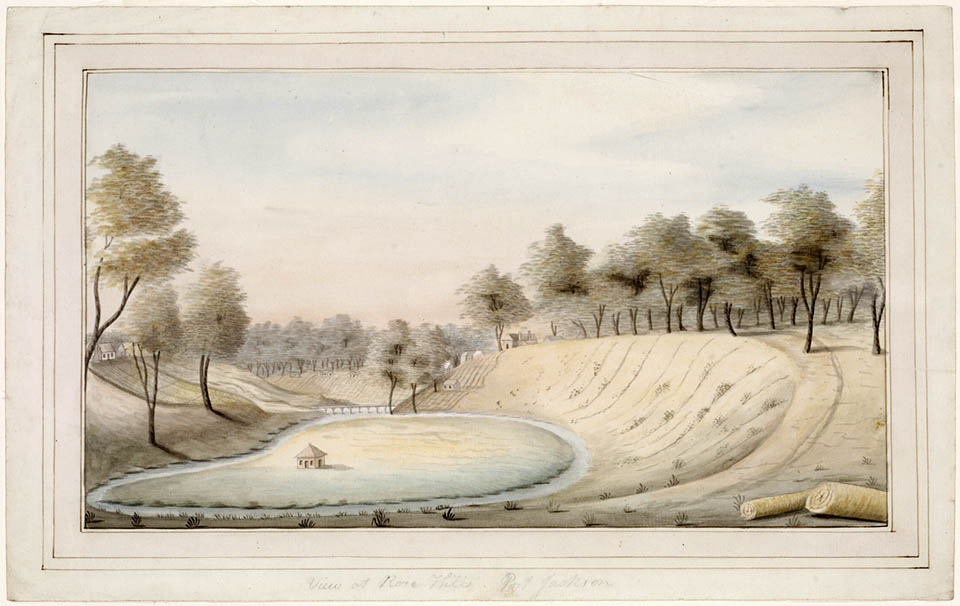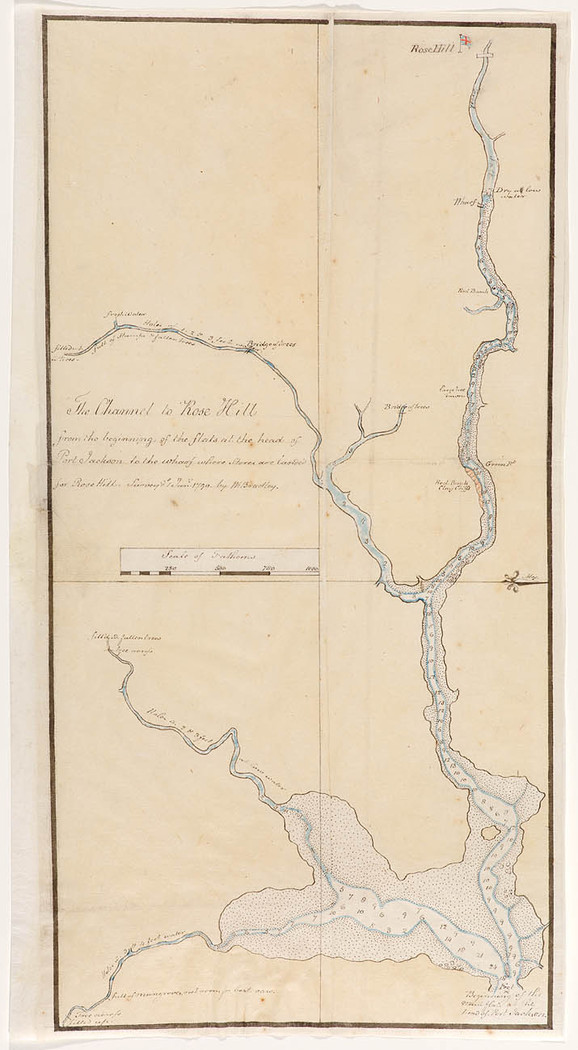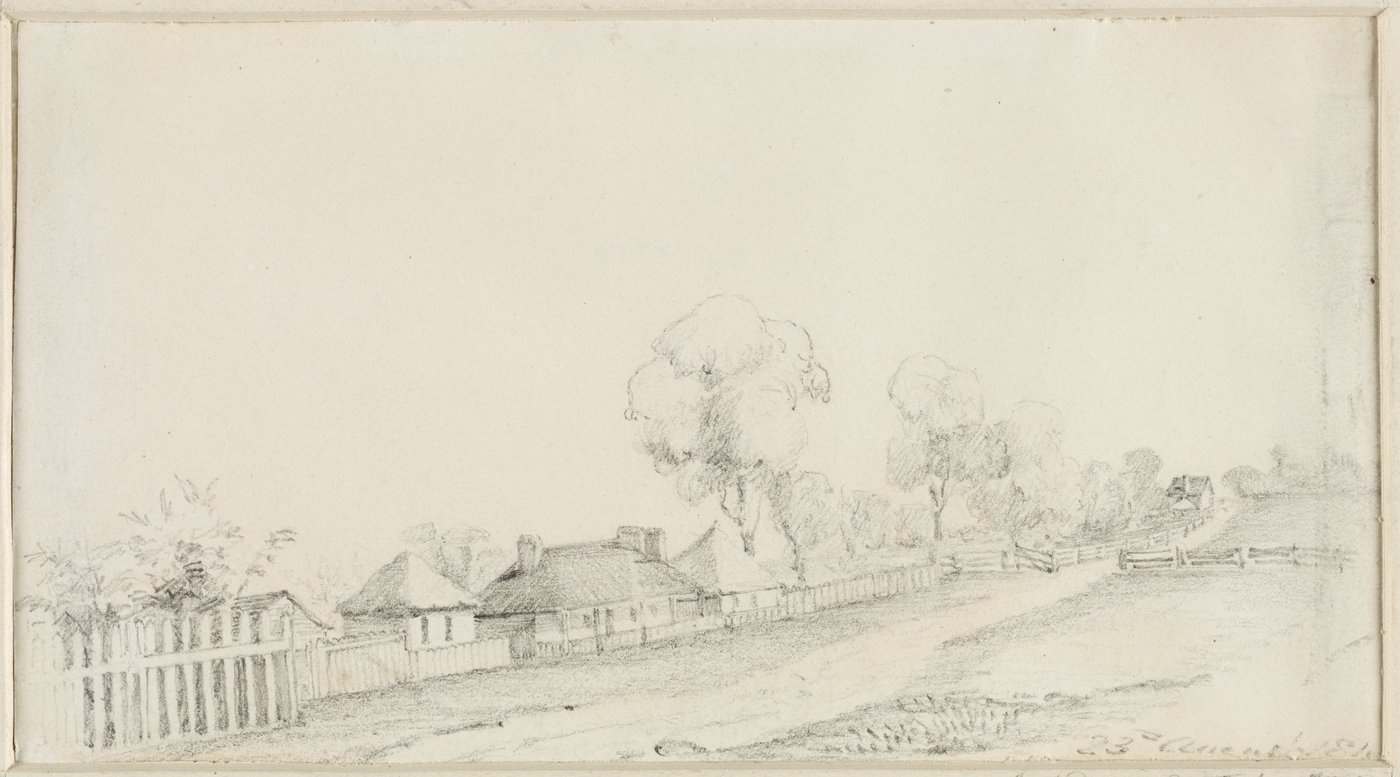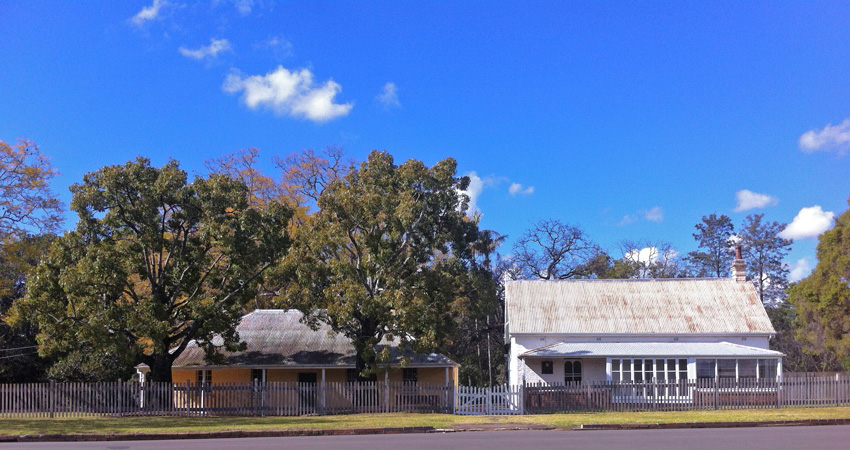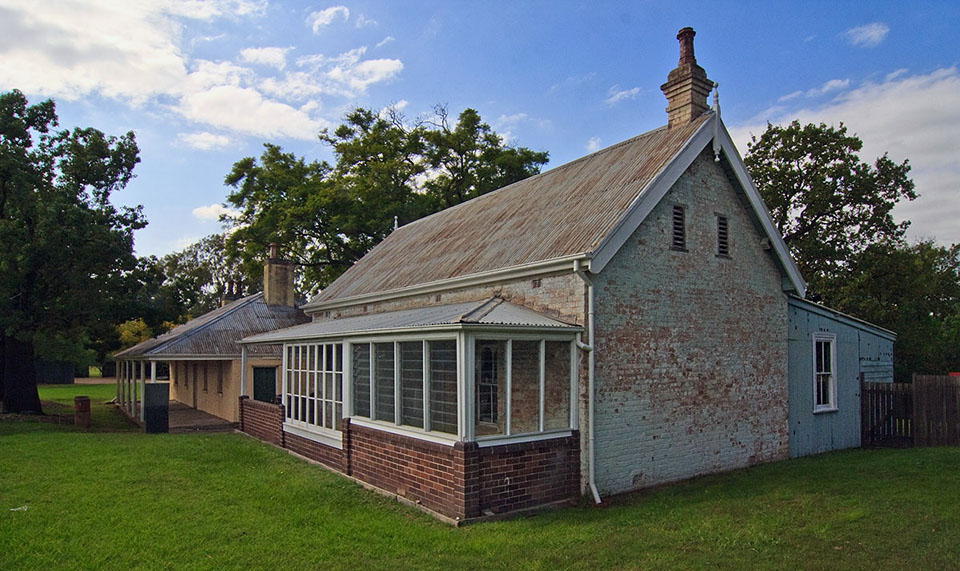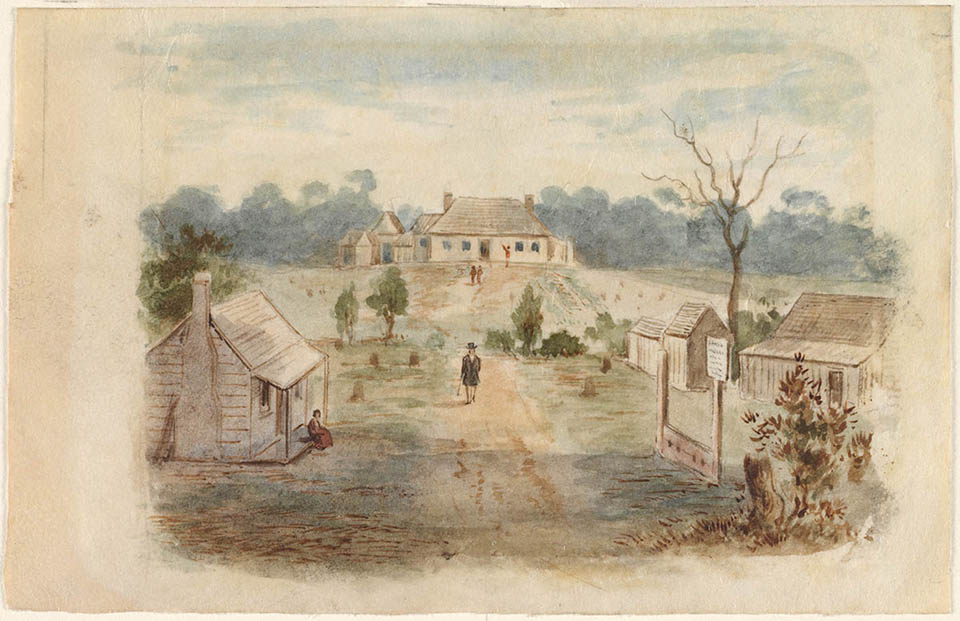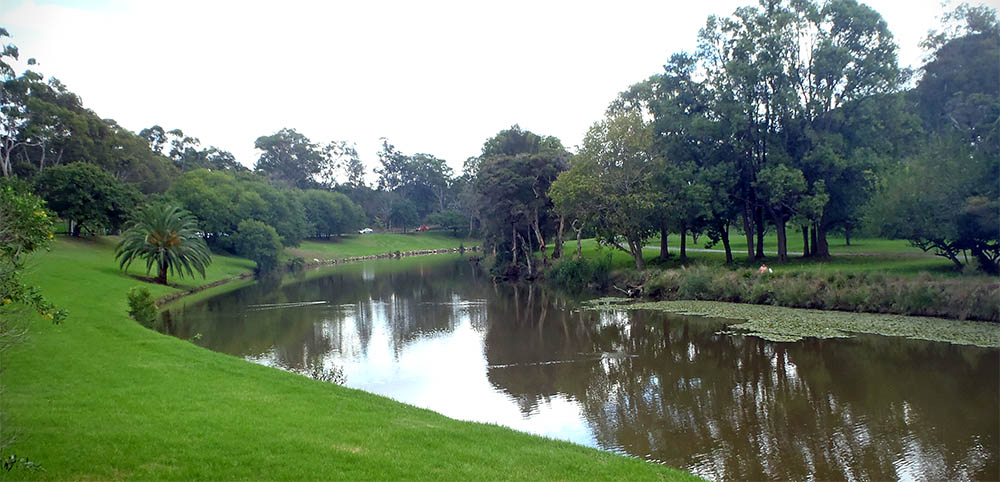The Dictionary of Sydney was archived in 2021.
The Crescent
Citation
Persistent URL for this entry
To cite this entry in text
To cite this entry in a Wikipedia footnote citation
To cite this entry as a Wikipedia External link
The Crescent
[media]The Crescent is the site where Governor Phillip established Australia's first inland settlement, Parramatta, on 2 November 1788. It is located on the Burramattagal's traditional hunting grounds in present-day Parramatta Park. On the hillside above the crescent-shaped 'alluvial flats contained in a bend in the river,' [1] Parramatta's first building was constructed as part of the fortified camp known as The Redoubt, which was completed in July 1789. The first Government House in Parramatta also stood within The Crescent from 1790 until 1799 when Old Government House was constructed. Immediately across the river was Government Farm, the first successful farm in the colony. At the opposite end of The Crescent stands the earliest surviving worker's cottage built by emancipist George Salter between 1798 and 1805 on farmland granted to him in 1796, which later became the Governor's Dairy. Beside the Dairy Cottage stands the Ranger’s Cottage, built in 1875. In 2014, extensive developments saw The Crescent become a public events space that references its rich colonial history.
Pre-Contact Aboriginal occupation
Between 10,000 and 22,000 years before European settlement, [2] Parramatta was the traditional hunting and fishing grounds of the Darug-speaking Burramattagal people. The fertile park-like landscape that later greeted the European settlers was shaped by the Burramattagal's practice of 'fire-stick farming.' [3] Scarred trees, artefacts and pathways are evidence of this pre-contact Aboriginal occupation. [4] As it was located on the bank of the Parramatta River, The Crescent would have also been used by the Burramattagal for fishing and camping purposes.
The quest for arable land
[media]Finding land suitable for farming was imperative to the survival of the new colony. Within days of the First Fleet's landing at Port Jackson on 26 January 1788, Governor Phillip made his personal servant, Henry Edward Dodd, overseer of a team of convict labourers tasked with clearing and cultivating land for the first Government farm at Farm Cove. Due to the sandy nature of the soil at this location, and a number of other obstacles, this agricultural venture was unsuccessful so explorations of the harbour began in earnest in February, followed by explorations on foot deeper inland in April. [5]
On 24 April 1788 a small party of the colonists led by Governor Phillip continued to explore along the Parramatta River until they came upon The Crescent, so named because a bend in the Parramatta River had cut 'a semi-circular shape into the hill whilst the river formed a [fresh water] billabong below.' [6] From the top of the hill at The Crescent – later named Rose Hill after George Rose, Secretary of the Treasury – it was evident that the land met the criteria for the location of a major township as it was both accessible to Sydney Cove and fertile enough to support the colony. The governor made plans to return in spring to establish the town that became Parramatta. [7]
Governor Phillip, together with Baron Augustus Alt, Lieutenant John Johnstone and eight marines, chose and marked out a fortified camp on 2 November 1788. Within days, a total of 20 convicts, three officers, four non-commissioned officers and 20 marines [8] were on site.
Governor Phillip's redoubt
[media]A sign behind Old Government House, [9] near the Boer War Memorial [10] and The Bath House, [11] dated 1966 states that it is the 'Site of Parramatta's first building, Governor Phillip's Redoubt 2nd November 1788.' [12] The 'first' building to which the sign refers was one of a cluster of buildings that comprised The Redoubt in November 1788 including the army barracks, a storehouse, outbuildings, the convict camp, a bridge, and a track from the wharf known as the 'Landing Place' (The King's Wharf). The track to the wharf became 'High Street' which was later named 'George Street.' The 1966 sign does not mark the precise location of the fortified camp but the general vicinity of the site, as The Redoubt was not at the hill's summit but 'a spot upon [the] rising ground' [13] between the river and the left-hand side of the later building, Old Government House. The Redoubt was therefore not far from the present-day Noller Bridge. [14]
While The Redoubt was being cleared and its buildings were under construction, tents served as temporary shelter on a flat section of land at the foot of the hill. This area has been home to public picnic facilities since the 1900s and is known as 'Pavilion Flat.' [15] When The Redoubt was completed, the convicts lived in huts that formed a line 'at some distance, in front of the barracks, with very good gardens before and behind each house.' [16] These first convict huts and gardens were located where the Murray Gardens are now situated, close to the late nineteenth-century George Street 'Tudor' Gatehouse and Lady FitzRoy Memorial. [17]
The Government Farm: 'Dodd's Farm'
The Redoubt overlooked Government Farm, the first successful farm in the colony, which was established in late 1788 on the opposite side of the river. Initially the farm's overseer was the inexperienced James Smith who was promptly replaced in March 1789 by the more experienced and highly skilled farmer, Henry Edward Dodd. [18] Superintendent Dodd produced 'a cabbage which weighed six-and-twenty pounds' and the 'other vegetable productions of his garden, which was by no means a rich mould, were plentiful and luxuriant' also. [19]
Salter's Farm/Governor's Dairy
[media]The true success of a penal colony was measured by how self-sufficient its convicts could become in their new land. By the time Second Fleet convict George Salter received his 30-acre (approximately 12 hectares) grant from Governor Hunter in 1796, on a section of The Crescent located a few minutes upstream from The Redoubt, the First Fleet convict James Ruse had already proven in 1789 that it was possible for a convict to become a self-sufficient farmer at Experiment Farm.[media] Between 1798 and 1805, Salter constructed a brick cottage that still stands on what was then known as 'Salter's Farm' and, like Ruse, Salter proved successful as a farmer. Governor Macquarie purchased the farm from Salter in 1813 and made it the Governor's Dairy, which supplied nearby government institutions including the Female Factory and Parramatta Gaol. A sunken milk processing room featuring a convict-built barrel drain was constructed beside the cottage during this period. [20] When the Governor's Domain became the public park known as 'Parramatta Park' in 1857, the original cottage served as the park ranger's residence
The Ranger's Cottage
[media]In approximately 1875, a new cottage was built for the park ranger directly beside Salter’s cottage, over the top of the dairy’s sunken milk room. Archaeologists removed floorboards in the front room of the Ranger's Cottage in 1993 to expose the old milk room.
Government houses
[media]The first Government House in the colony was built at Sydney Cove in 1788 but the first Government House in Parramatta was built for Governor Phillip in 1790 on the ascending hill of The Crescent. It was a small single-storey cottage measuring 44 feet (approximately 4 metres) long and 16 feet (4.9 metres) wide made from lath and plaster. Archaeological excavations have revealed remnants of a carriage entrance built by convicts which was also a part of Phillip's original Government House. [21]
[media]By 1799 Phillip's Government House had deteriorated so much that a new Government House was constructed higher up on the summit of the same hill at The Crescent. This 'new' Government House is now referred to as 'Old Government House.' In 1799 the building only consisted of the main central block as the side extensions that are visible today were added by the Macquaries between 1815 and 1817. [22]
Event space
[media]In November 2013 representatives of the Parramatta Park Trust, the Government Architect's Office and Context Landscape Design Pty Ltd proposed The Crescent be developed '…as a venue for temporary public events such as concerts' [23] in a presentation to the Heritage Council of New South Wales Approvals Committee.
Nine and a half million dollars was subsequently spent upgrading The Crescent to increase its appeal to promoters and major international acts as a venue for large-scale events 'capable of accommodating up to 15,000 people.' [24] The changes include a new staging area that mimics The Crescent's natural shape 'paved in stone with colour gradations to reflect a river bed's siltation layers.' [25] In another reference to The Crescent's colonial landscape, areas of 'gravel and lawn defined by long bands of planting and pavement reminiscent of the wheat rows of the colonial period,' and native trees have been added. [26] As part of these developments, oak trees will also line Byrnes Avenue as a buffer 'between the staging area and road way.' [27]
These improvements were part of a larger $35.4 million project to upgrade Parramatta Park after its UNESCO World Heritage listing on 31 July 2010 as one of 11 historic sites that together form the World Heritage Australian Convict Sites. [28]
References
Collins, David. An Account of the English Colony in New South Wales, Vol. 1. London: T Cadell Jnr and W Davies, 1798. Available online at http://www.gutenberg.org/files/12565/12565-h/12565-h.htm. Viewed 7 January 2015.
Hunter, John. An Historical Journal of the Transactions at Port Jackson and Norfolk Island. London: John Stockdale, 1793. Available online at http://www.gutenberg.org/files/15662/15662-h/15662-h.htm, viewed 10 January 2015
Terry Kass, Carol Liston and John McClymont. Eds. Parramatta: A Past Revealed. Parramatta: Parramatta City Council, 1996.
'A History of Dispossession.' Parramatta Park Trust. http://www.parrapark.com.au/History/aboriginal-history-1/a-history-of-dispossession. Viewed 10 January 2015.
Notes
[1] 'The Crescent,' Parramatta Park Trust, http://www.parrapark.com.au/History/european-history/the-crescent, viewed 9 January 2015
[2] 10,000 plus years is the conservative date but use of this land for hunting and fishing could easily date back 15,000 to 22,000 years when taking into account the archaeological evidence of Aboriginal presence discovered in 200–05 during excavations of 109–113 George Street, Parramatta. According to Casey and Lowe, recent archaeological work at the eastern end of George Street indicates the presence of Aboriginal people in Parramatta as extending back 15,000 to 22,000 years BP. The 109–113 George Street site is the oldest known archaeological site revealing Aboriginal presence in the Sydney region indicating the known location of Aboriginal existence prior to stabilisation of post-glacial sea levels c.6000 years ago.' Mary Casey and Tony Lowe, 'Parramatta Children's Court Site: Results of the Archaeological Investigation' (Marrickville: Casey and Lowe Pty Ltd, 2006), 51, http://www.caseyandlowe.com.au/pdf/pcc/pccs3.pdf, viewed 6 January 2015
[3] Verena Mauldon, Colonial Rose Hill, tour guide (Parramatta: Parramatta Park Trust, 2004), 2, http://www.parrapark.com.au/things-to-do/tours/tourguides/ColonialRoseHill.pdf, viewed 10 January 2015; 'A History of Dispossession,' Parramatta Park Trust, http://www.parrapark.com.au/History/aboriginal-history-1/a-history-of-dispossession, viewed 10 January 2015
[4] Verena Mauldon, Colonial Rose Hill, tour guide (Parramatta: Parramatta Park Trust, 2004), 2, http://www.parrapark.com.au/things-to-do/tours/tourguides/ColonialRoseHill.pdf, viewed 10 January 2015
[5] Terry Kass, Carol Liston and John McClymont, Parramatta: A Past Revealed (Parramatta: Parramatta City Council, 1996), 9
[6] Terry Kass, Carol Liston and John McClymont, Parramatta: A Past Revealed (Parramatta: Parramatta City Council, 1996), 12
[7] Terry Kass, Carol Liston and John McClymont, Parramatta: A Past Revealed (Parramatta: Parramatta City Council, 1996), 10–4
[8] Terry Kass, Carol Liston and John McClymont, Parramatta: A Past Revealed (Parramatta: Parramatta City Council, 1996), 14
[9] Central block of house completed in 1799, side extensions date from 1815.
[10] Erected in 1904
[11] Erected 1822
[12] Terry Cass et al. state, 'The myth that [The Redoubt] stood on top of Rose Hill persists because of an early 20th century plaque placed there.' Terry Kass, Carol Liston and John McClymont, Parramatta: A Past Revealed (Parramatta: Parramatta City Council, 1996), 15. It is the close proximity of this sign dated 1966, to an engraved stone dated 1913, commemorating the erection of the first Government House in Parramatta that has caused the confusion. The two signs refer to two different 'first' buildings; the 'first' building in Parramatta, which was part of the fortified camp or The Redoubt, and the 'first' Government House. To add to the confusion, neither Parramatta's first building nor the first Government House in Parramatta was located in this exact location but close by. The 1913 stone merely commemorates the erection of the Government House, and a commemorative stone can technically be placed anywhere, its placement does not automatically imply that it marks the spot. Only the 1966 sign gives the impression to the reader that the sign marks the actual spot of the 'first building' because of its use of the word 'site.' Yet, 'site' can just as easily refer to the general vicinity of The Crescent, so that the error is not in the text of the 1996 sign itself or, for that matter, the 1913 stone but occurs solely in the mind of the reader.
[13] David Collins, An Account of the English Colony in New South Wales, Vol. 1 (London; T Cadell Jnr, and W Davies, 1798), 45. Available online: http://www.gutenberg.org/files/12565/12565-h/12565-h.htm viewed 7 January 2015, viewed 7 January 2015
[14] Built 1925
[15] 'Choose an Area,' Parramatta Park, http://www.parrapark.com.au/book-an-area/choose-an-area, viewed 10 January 2015; Terry Kass, Carol Liston and John McClymont, Parramatta: A Past Revealed (Parramatta: Parramatta City Council, 1996), 15
[16] 'Chapter XV' in John Hunter, An Historical Journal of the Transactions at Port Jackson and Norfolk Island (London, John Stockdale, 1793). Available online: http://www.gutenberg.org/files/15662/15662-h/15662-h.htm, viewed 10 January 2015
[17] The Tudor Gatehouse was designed and erected in 1884 while the Lady FitzRoy Memorial was erected in 1888.
[18] Terry Kass, Carol Liston and John McClymont, Parramatta: A Past Revealed (Parramatta: Parramatta City Council, 1996),17
[19] David Collins, An Account of the English Colony in New South Wales, Vol.1 (London; T Cadell Jnr and W Davies, 1798), 91. Available online: http://www.gutenberg.org/files/12565/12565-h/12565-h.htm, viewed 7 January 2015; 'Chapter XV' in John Hunter, An Historical Journal of the Transactions at Port Jackson and Norfolk Island (London, John Stockdale, 1793). Available online: http://www.gutenberg.org/files/15662/15662-h/15662-h.htm, viewed 10 January 2015
[20] 'The Dairy Cottage,' Parramatta Park Trust, http://www.parrapark.com.au/History/european- history/the-dairy-precinct, viewed 16 January 2015
[21] Verena Mauldon, Colonial Rose Hill (Parramatta: Parramatta Park Trust, 2004), 2, http://www.parrapark.com.au/things-to-do/tours/tourguides/ColonialRoseHill.pdf, viewed 10 January 2015
[22] Verena Mauldon, Shaping the Domain: The Government Domain, Parramatta 1788–1856 (Parramatta: Parramatta Park Trust, 2012), 2, http://www.parrapark.com.au/things-to-do/tours/tourguides/Parramatta%20Park%20World%20Heritage.pdf, viewed 10 January 2015
[23] Minutes of meeting, Heritage Council of NSW Approvals Committee, Parramatta Heritage Branch, 20 November 2013, 2, http://www.environment.nsw.gov.au/resources/heritagebranch/heritage/heritagecouncil/acmin2013Nov20.pdf viewed 9 January 2015
[24] 'Transformation of Parramatta Park Begins,' New South Wales Government, http://www.nsw.gov.au/news/parramatta-park-upgrade, viewed 9 January 2015
[25] Minutes of meeting, Heritage Council of NSW Approvals Committee, Parramatta Heritage Branch, 20 November 2013, 2, http://www.environment.nsw.gov.au/resources/heritagebranch/heritage/heritagecouncil/acmin2013Nov20.pdf, viewed 9 January 2015
[26] Minutes of meeting, Heritage Council of NSW Approvals Committee, Parramatta Heritage Branch, 20 November 2013, 2, http://www.environment.nsw.gov.au/resources/heritagebranch/heritage/heritagecouncil/acmin2013Nov20.pdf viewed 9 January 2015
[27] Minutes of meeting, Heritage Council of NSW Approvals Committee, Parramatta Heritage Branch, 20 November 2013, 2, http://www.environment.nsw.gov.au/resources/heritagebranch/heritage/heritagecouncil/acmin2013Nov20.pdf, viewed 9 January 2015; Di Bartok, 'NSW Government announces $2 million to build infrastructure for entertainment in Parramatta Park,'' Parramatta Advertiser, 25 March 2014, http://www.dailytelegraph.com.au/newslocal/parramatta/nsw-government-announces-2-million-to-build-infrastructure-for-entertainment-in-parramatta-park/story-fngr8huy-1226863447839, viewed 9 January 2015
[28] These upgrades were carried out by the Government Architect's Office with funding assistance from the Commonwealth Government.
.



